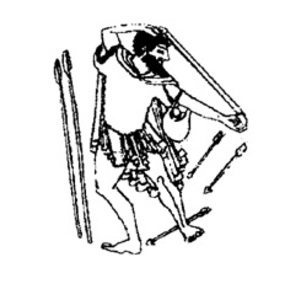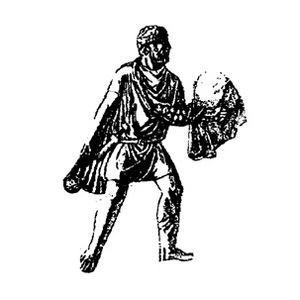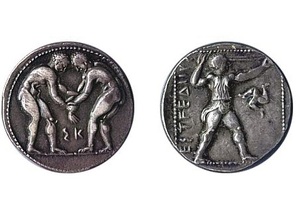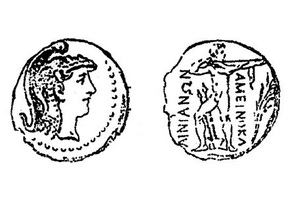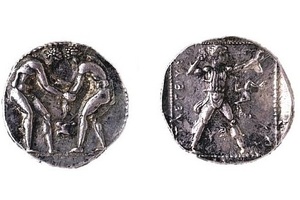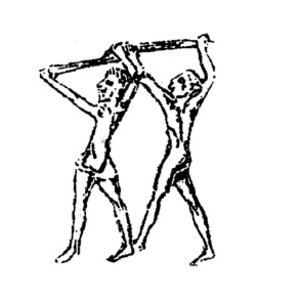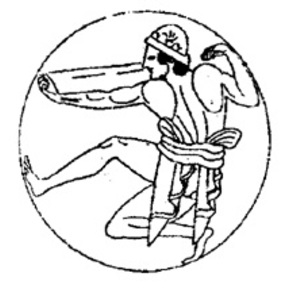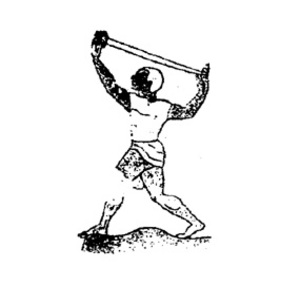Slinger
A slinger, also known as a fustibalus (from the Latin funda - sling), was a lightly armed ancient warrior who engaged in medium-range combat using a sling as his primary weapon.
The sling was a flexible, rigid, or combined throwing weapon used in warfare or hunting. It was designed to throw stones or specially made projectiles, typically made of lead. It is considered one of the predecessors of siege engines.
In antiquity, the rope sling was the most widely used. It had an enlarged section in the center where typically one projectile (a regular stone, a ceramic or metal ball, etc.) was placed. One free end had a loop that was worn on the wrist or finger to secure the sling during the throw. The slinger held the other free end with the same hand. Slinging was usually done in loose formation, as the shot required a sharp spin of the sling and free space. To throw the projectile, the slinger would spin the sling with the projectile in a horizontal plane (usually above their head) to increase the range, accuracy, and speed of the projectile, gradually increasing the circular motion, and at the moment of the strongest swing, would release the free end of the sling. For slinging in relatively tight formations, Greeks and Romans could use a more compact vertical spinning technique.
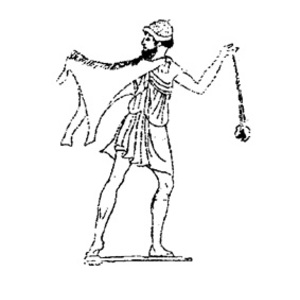 Image of a Greek slinger on a Greek amphora. Found in: Nola. Sling length: 69-70 cm. Projectile diameter: about 10 cm. Dated to the 5th century BC.
Image of a Greek slinger on a Greek amphora. Found in: Nola. Sling length: 69-70 cm. Projectile diameter: about 10 cm. Dated to the 5th century BC.History
The sling was a simple device for throwing stones. It was known to most peoples before the ancient era, so it cannot be credited as an outstanding invention by any particular culture. The sling was actively used in the armies of the ancient world (Egypt, Greece, Rome, and others).
The sling's effectiveness was limited, but it could be greatly enhanced by the use of specially made projectiles. Moreover, its main value lay in its simplicity: a sling strap was easy to find or make, and stone ammunition was virtually free, as it could be easily made or even found on the battlefield. Anyone could become a slinger on the battlefield, regardless of wealth. The poorest warriors were often used in battles as skirmisher-slingers.
Stones chosen for throwing were preferably smooth (for better aerodynamics) and round, weighing between 200-400 grams. Such a projectile could be given sufficient kinetic energy to harm an enemy, typically around 400 joules (for comparison, crossbow bolts in flight had kinetic energy between 100 and 500 joules, arrows usually no more than 300 joules, and a bullet from a Makarov pistol has about 320 joules). The slinging range was approximately 90 meters. However, accuracy was usually an issue: aiming with a sling was extremely difficult, and even an experienced slinger could not account for all the individual characteristics of the shape and weight of the projectile.
 Relief depicting Germanic slingers on the Column of Marcus Aurelius Antoninus in Rome. Late 2nd century AD.
Relief depicting Germanic slingers on the Column of Marcus Aurelius Antoninus in Rome. Late 2nd century AD.
As an alternative to stone, clay bullets were often used — entire caches of such projectiles, as well as molds for their quick production, have been found in ancient ruins. Clay balls had lower density and did not fly as well as stones, but they were consistent in weight and shape, which improved shooting accuracy.
The sling's effectiveness was significantly increased when heavy iron or especially lead bullets were used. In this case, the effective range was comparable to that of bows (lead bullets could fly up to 280 meters, iron ones up to 180 meters, and their lethality was greatly increased).
Such weapons were used by the armies of Assyria, Persia, Greece, Rome, and Carthage. Despite the bow being much more accurate, slingers with metal projectiles were sometimes valued more than archers: heavy projectiles retained greater lethality throughout their flight.
The practice of slinging lead projectiles declined with the fall of ancient civilization, as shooting with such projectiles became too expensive (about 40 kilograms of lead were needed for a hundred shots). Slingers were also costly to train: learning to accurately sling projectiles was more difficult than learning to shoot a bow.
Below are some findings of sling projectiles:
1. One of 11 bullets found in Cyprus, at Hala Sultan Tekke. Dated to the 12th century BC. Shape: slightly flattened ellipsoid. Material: lead. Weight: 35 g. Dimensions: 3.6 x 1.6 x 1.0 cm. Many similar bullets, dating to this or even earlier periods, have been found in other places in Cyprus, as well as in Crete. Astrom P. Lead Sling Bullets... p. 22, 32.
2-20. Various ancient Greek sling projectiles found in different locations across the ancient world. Shape: ellipsoid. Material: lead. Vischer W. Antike Schleudergeschosse // Kleine Schriften. B. II. Leipzig, 1877-78. Taf. I, XIII, XIV.
19-20. Fougeres G. Glans. p. 1610. Ancient casting mold for sling projectiles (Drawing). Found in Phanagoria (Taman Peninsula on the northern coast of the Black Sea). Material: clay. Fougeres G. Glans. p. 1609.
22-23. Etruscan sling bullets. Shape: ellipsoid. Material: lead. Henry В. Les balles de fronde etrusques en plomb // Actes du 101 congress national des societes savantes. Lille, 1976. Paris, 1978. p. 18, 19.
Another interesting fact is that sling projectiles could be customized. For example, the tradition of inscribing messages on projectiles dates back to ancient times. "Looking for Octavian's backside!" — this is written on a lead sling bullet found by archaeologists near Perugia, where in 41 BC, Lucius, the brother of Mark Antony, and his wife Fulvia were besieged by Octavian's army. Another projectile, found in the same place, was apparently intended for the opposing side. The inscription on it reads: "Lucius Antonius, the bald, and Fulvia — open your backsides." Sometimes, especially among the Romans, the messages were personalized and contained insults aimed at enemies, such as "For Pompey's backside."
For more information on the archaeology and use of slings, see the article Projectiles, Ballistae, and Bersnwark.
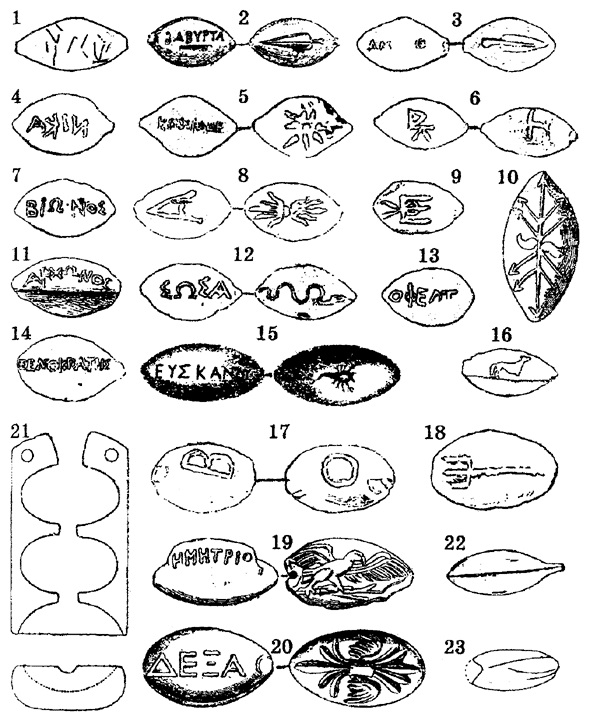 Table No. 1 - Sling Projectiles
Table No. 1 - Sling Projectiles
Balearic Slingers
Balearic slingers were the most famous light infantry mercenaries in antiquity, professionally skilled with the sling. They were hired from the Balearic Islands. According to Diodorus Siculus, their name comes from the Greek verb βάλλειν (to throw).
Balearic slingers gained wide recognition serving as mercenaries or allies in the armies of Carthage and later Rome.
Diodorus Siculus wrote:
"They have three slings, one of which is on the head, another around the waist, and a third in the hand; using this weapon, they are capable of throwing larger projectiles than other slingers, and with such force that it seems as if the projectile was shot from a catapult. Because of this, during attacks on cities, they can destroy the defenders on the walls, and in battles in open fields, they can break a large number of shields, helmets, and armor of all kinds."
Balearic slingers were mercenaries, and their payment consisted primarily of items scarce on the islands: wine, oil, or women.
Their high combat skills made them famous throughout the Mediterranean. Balearic slingers were known for both the accuracy of their throws and the weight of their projectiles. They used the heaviest projectiles. They participated as mercenaries in the First and Second Punic Wars on the side of the Carthaginians. These wars marked the rivalry between Carthage and Rome. The slingers from the Balearic Islands served under the command of Hamilcar Barca, his son-in-law Hasdrubal, and his sons Hannibal, Hasdrubal, and Mago.
When Rome decided to conquer the islands, Quintus Caecilius Metellus Balearicus ordered his ships to be covered with hides, as the slingers' shots could sink them. The Roman legions took two years to conquer the islands. After the conquest, the Balearic slingers were incorporated into the Roman auxiliary forces.
Related topics
Auxiliaries, Sagittarius, Projectiles, Ballistae, and Bersnwark
Literature
- Skobelev D. A. Slingshot: projectiles and methods of throwing in Antiquity. Publication on the portal "X Legio".
- Diodorus of Sicily. Historical Library, V, 18.

 Gallery
Gallery






